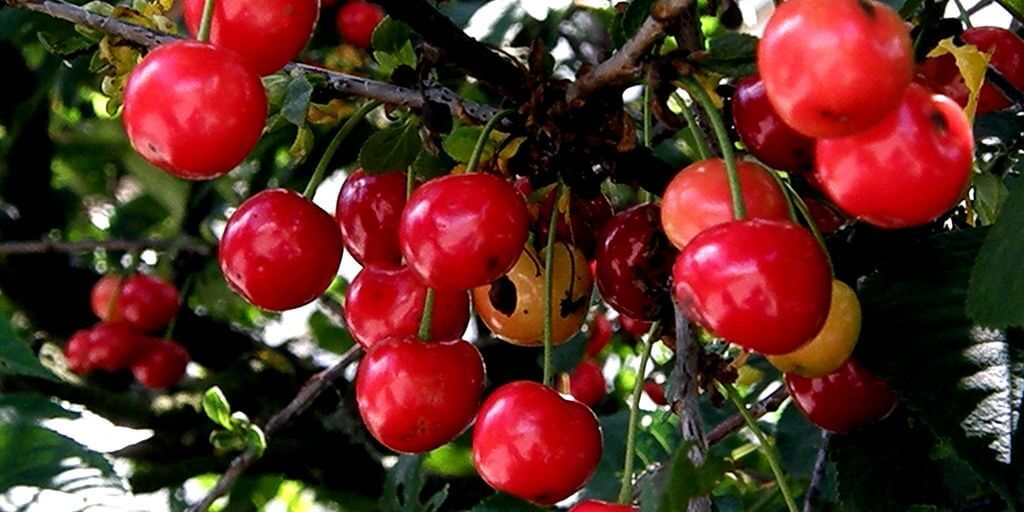Acerola, (Malpighia emarginata), is a tropical fruit prized for its high vitamin C content. The fruit is small, red to orange-red, and has a tart flavor. It contains not only vitamin C but also other nutrients such as vitamin A, vitamin B, and antioxidants. Acerola is used to make juices, jams and other food products and is valued for its health benefits, including immune system support and skin health improvement.
Acerola Tree
Acerola is a small tree or bushy shrub that originates from the tropical regions of the Americas. Specifically, it is native to South America, including countries like Brazil, as well as parts of Central America and the Caribbean. It is now cultivated in various tropical regions worldwide.
Acerola grows best in tropical-type climates and has little cold tolerance due to its shallow root systems. It is also known as; Barbados cherry and West Indian cherry.
Acerola is widely distributed in the warmer climates of the southern United States such as Florida and Texas, as well as in the central and northern part of South America. The plant is also grown throughout the Caribbean and subtropical regions. Currently, Brazil is the largest mass cultivation of the plant.
Its leaves are a lush, shiny green that varies between light and dark shades and the floral part of the plan blooms with five small pink to white petals.
Acerola Fruit
The actual fruit of the plant, which is the part used medicinally, is a bright red or orange-yellow cherry-sized lobe that contains small seeds. The pulp of the fruit offers a delicately sweet aroma and flavor but is acidic.
Once the fruit is harvested from the plant, it must be quickly used or converted to its supplemental form because spoilage is rapid. After three to five days, the picked fruit ferments and becomes unpleasant, develops mould and loses its healthy properties.
Health Benefits of Acerola
Historically, the natural form of the fruit was harvested and used to treat a number of ailments such as diarrhea or inflammation of the intestines. In modern times it is popular as an alternative supplement to relieve symptoms of the common cold, primarily due to its high vitamin C content.
The supplements are also promoted as energy boosters for athletic endurance, as a means of minimizing symptoms of depression and relieve gum and tooth infections.
Vitamins in Acerola
Vitamin C
Acerola is an important source of vitamin C in the natural form of ascorbic acid and contains between 1000 and 4500 milligrams per 100 grams of edible fruit. Vitamin C is an essential dietary nutrient that plays a role in immune system health. It is also important in the synthesis of collagen, a structural component of bones, skin and blood vessels, as well as in the synthesis of brain chemicals involved in mood regulation.
The vitamin C content is higher in less ripe fruit and, after harvesting, the percentage of vitamin C can be preserved by freezing the plant.
Vitamin A
Vitamin A is another important nutrient found in Acerola, yielding as much as a full-sized bunch of carrots, or approximately 3,400 to 12,500 international units per 100 grams of fruit. Vitamin A plays a role in visual health, normal growth and continued development, red blood cell production, and protects the immune system.
Additional Micronutrients
Additional micronutrients found to a lesser degree in fruit include; several B vitamins, calcium, iron, potassium and magnesium. Each of which is necessary in a normal diet. Fruit also contains protein, fiber/fiber, and fatty acids, important dietary macro-nutrients.
How to Take Acerola
Acerola supplements are available as a powdered extract to mix with water, fruit or vegetable juices. There are also topical cream formulations for direct application to the skin to improve elasticity and collagen production or for use as an antifungal remedy.
There is no standard dosage for Acerola supplements, as dosing depends on several variables, including age, current health, and pre-existing conditions. The common dosage is one level teaspoon, or 3.6 grams, of powder mixed with an 8-ounce beverage and taken three to five times a week. Some manufacturers may also market acerola in oral capsule form as vitamin C. Check package labeling for proper instructions.
Acerola Clinical Evidence
Clinical evidence suggests that the high antioxidant properties, which come from vitamins A and C, of acerola could serve as an important element in the regular diet, as demonstrated by several published research studies. Research is underway to determine its exact benefits and possible long-term adverse effects.
Shopping
| Visit the new SHOPPING page for a wide selection of amazing products! |
Always take care when taking herbs and Read Our Disclaimer.
Acerola Herb Notes / Side Effects
Acerola is generally considered safe when supplements are used as directed. However, Acerola interacts with blood thinners and hormonal medications.
Acerola may also cause side effects such as nausea, cramps and diarrhea, particularly due to the high vitamin C content, which is known to cause diarrhea when taken in high doses.
People with gout or kidney stones may have complications when taking acerola due to the vitamin C content.
It is unknown if using Acerola during pregnancy or breastfeeding causes harmful side effects. As a safety precaution, consult a doctor before taking Acerola supplements.
Have you tried Acerola? Share your experience in the comments below!


Leave a Reply